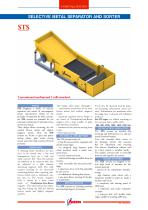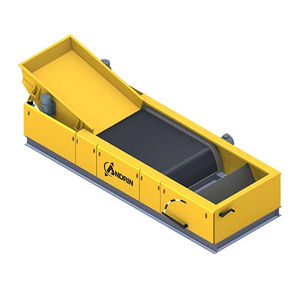
Eddy current separator STSbeltmetalfor non-ferrous metals



Add to favorites
Compare this product
Characteristics
- Technology
- eddy current, belt
- Separated substance
- metal, for non-ferrous metals
- Weight
1,050 kg, 1,770 kg, 2,600 kg, 3,000 kg
(2,314.85 lb, 3,902.18 lb, 5,732.02 lb, 6,613.87 lb)
Description
STS designates a family of selective separators and sorters of non-magnetic metals (non-ferrous). Based on the principle of separation by eddy currents, the STS systems are intended for the automatic purification of materials versus non-ferrous metals.
Their design allows extracting the few residual ferrous metals and slightly magnetic metals. Thus, the STS systems are found in glass and plastic sorting plants, glass works, sorting centers and other high pureness physical processes.
OPERATION
A vibrating feeder distributes the product to be treated into a fine and homogeneous layer on a wide and rapid conveyor belt. Once the materials are stabilized on the conveyor belt, they are subjected to a high intensity alternating magnetic field. The eddy currents resulting in the electrically conducting bodies allow repulsing nonferrous metals such as aluminum, copper, zinc, etc. The intense magnetic field is created by a polar wheel made of Neodymium-Iron-Boron magnets. This wheel allows also separating after leaving the field the residual ferrous metals and slightly magnetic particles.
This design offers many advantages :
•simultaneous purification of the nonferrous metals and residual magnetic metals,
•maximum repulsion power thanks to the choice of Neodymium-Iron-Boron magnets with a large number of poles and minimum clearances,
•treatment of fine particles starting from 2 mm,
•effectiveness on lead.
Catalogs
STS
2 Pages
*Prices are pre-tax. They exclude delivery charges and customs duties and do not include additional charges for installation or activation options. Prices are indicative only and may vary by country, with changes to the cost of raw materials and exchange rates.



